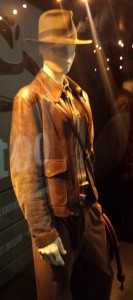
Editing is hard work that leaves you slightly scattered making it difficult to come up with a blog post that stays on topic. Thus, here are the very random thoughts about worth, value, museums, and mermaids swirling in my head.
I recently attended the National Geographic Museum’s Indiana Jones and the Adventures of Archaeology. Blending movie magic with actual artifacts the exhibit left me with struggling with the idea of value and how it is defined. What makes something important?
The exhibit started with the costume worn by Harrison Ford and then showed the famous Ark of the Covenant, before moving on to ancient necklaces, a series of stone carvings, and the first map. It was hard to tell the movie props from the actual artifacts. I started by wondering what was real, and then immediately wondered why it mattered. Does the experience an item provides make it valuable?
While the exhibit was meant to showcase actual archaeologists and explain their work, most attendees clustered around the props, costumes, and movie memorabilia. Are those items not as much of a representation of our culture as the real things kept under glass? Popularity certainly didn’t seem to be related to the archaeological value of the item on display. Winding my way around the exhibit I found ample room by the ancient pot shards and antique photos of actual digs but barely enough space to breathe next to the crystal alien skull props. Does popularity define value?
One exhibit box showed an ancient shell necklace and a modern diamond engagement ring, explaining that the two are roughly equivalent. Both are items that were/are considered precious by their culture but are actually easily obtainable. Diamonds are a common stone; their scarcity is a marketing device. Shell necklaces impressed ancient people without the means to travel to the ocean, but today they’re tourist trinkets. Yet somehow, both diamonds and shells were used to signify relationships. Does the value of a thing reflect the value of what it represents?
One of my editors told me to work on world building, to tell more about how the mermaids live, how their world works, if people know about them, and so on. But while the main character is a mermaid, she doesn’t want to be. She deliberately shuns mermaid culture, choosing to learn about biology, history, and life on dry land instead. For her the value of any mermaid item would be less than the value of any human item. Regardless of representation or popularity, individual beliefs about an item change its value…but only for the individual. I don’t like diamonds, but that doesn’t mean they’re worthless. Museum goers would rather read about special effects than the rosette stone, but the stone is still extremely important. So maybe usefulness determines value?
When I moved I gave up a lot of useful things. Decorative cupcake stands I loved but rarely used, more plates and dishes than most families needed, and a vintage sled un-ridden in years, all went to another home. While I still thought they were valuable, they didn’t have a place in my life anymore. The last year or two have been a season of shedding for me. I want more experiences and more time with the people I love, but I’m not keen on having more things. At the same time I want to be sure I’m keeping what matters. I wish I had an easy way to judge the value of a thing.